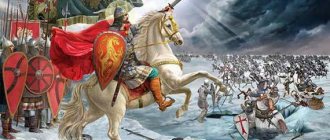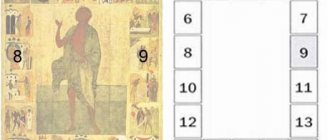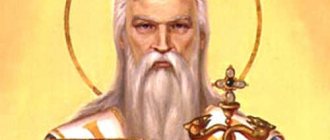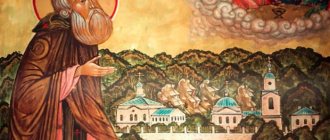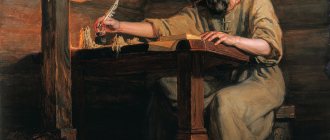GLEB ANDREEVICH
(mid 60s of the 12th century - after 1190), bgv. book (memorial on June 20, June 23 - in the Cathedral of Vladimir Saints). The earliest mention of G. A. as the 3rd son of Blgv. book Andrei Yuryevich Bogolyubsky (along with 2 older brothers Izyaslav and St. Mstislav) is contained in the princely genealogy, dating back to the Novgorod-Sophia arch of the 30s. XV century, - as part of the Sofia I Chronicle of the older edition, the Novgorod IV Chronicle, etc. (PSRL. T. 6. Issue 1. Stb. 18; T. 4. Part 1. P. 14, etc.). Chronicles of the 12th century. They also know 3 sons of Andrei Bogolyubsky, but they call the youngest Georgy. According to the hypothesis of E.E. Golubinsky, Gleb is the princely name of George. In the Life of G. A. (beginning of the 18th century), George is mentioned as the brother of G. A.
The Ipatiev Chronicle reports that in the winter of 1172/73, after fleeing Vel. Novgorod book Rurik Rostislavich, Prince. Andrei Bogolyubsky sent “his child Yurya and received him with honor” to the Novgorodians (PSRL. T. 2. Stb. 566), the prince was then a child. In 1173 Prince. Andrei Yuryevich sent an army against the Smolensk Rostislavichs led by Prince. Georgy Andreevich and governor Boris Zhidislavich. After the murder of Andrei Yuryevich (June 29/30, 1174), the question of his successor was discussed at the council of the squad in Vladimir, it was said that “our prince has been killed, but his children are gone, his little son is in Novgorod, and his brothers are in Rus'” (PSRL T. 2. Stb. 595; see also: T. 1. Issue 2. Stb. 371). In 1175 Prince. George was recalled from Novgorod, lived in Vladimir, in the beginning. June 1176 he came with the Vladimir people to Moscow, where he met his uncle blgv. Princes Mikhail and Vsevolod (Dimitri) Yuryevich.
Blgv. book Gleb Andreevich. Painting of the Archangel Cathedral of the Moscow Kremlin. 1652-1666 Blgv. book Gleb Andreevich. Painting of the Archangel Cathedral of the Moscow Kremlin. 1652-1666
The further fate of the prince was reflected in the cargo. and Byzantine. sources reporting that Georgy Andreevich was expelled from Rus' led. book Vsevolod the Big Nest, lived with the Polovtsians in Sviyazh, in 1185 he was invited to Georgia, where he married the daughter of King George III, Queen Tamara. Georgy Andreevich made a successful campaign against the Seljuk Turks, took part in court intrigues against Tamara and paid for it with deportation to Byzantium. In 1190, he returned to Georgia and led an armed movement of the nobility against the ruler, but was defeated and was again exiled to K-pol. Cargo. The chronicles know another speech by Georgy Andreevich at the head of the opposition forces against the former. spouses, but it also ended unsuccessfully for the prince, who had to flee (Essays on the history of the USSR: The period of feudalism, IX-XV centuries. M., 1953. Part 1. pp. 573-574).
For the first time G. A. is named among the princes buried in the Vladimir Assumption Cathedral in the “Extract of memorial services”, the compilation of which is associated with John IV Vasilyevich and probably dates back to 1550, when the tsar visited Vladimir (Painting of memorial services for the Vladimir princes // LZAK. 1910. Issue 22. P. 67). The “extract” indicates that in the cathedral, among other things. Princes and bishops buried 3 sons of Andrei Bogolyubsky: Izyaslav, Mstislav and Gleb. Inventory of Vladimir tombs, 1st half. XVII century reports the burial in the cathedral “in rose tombs” of 3 sons of the prince, not named. Andrei Bogolyubsky (RNB. OLDP. O-5. L. 194), in the inventory ser. XVII century their burial in one tomb is already mentioned, while about (Description of the tombs of the city of Vladimir in the middle of the 17th century // Vinogradov A.I. History of the department of the Assumption Cathedral in the provincial city of Vladimir. Vladimir, 19053. Appendix p. 67 ). The compiler of the inventory does not specify which incorrupt remains of which of the prince’s sons. Andrei Bogolyubsky is revered. The identification of the incorruptible relics resting in the common tomb of the sons of Andrei Bogolyubsky with the remains of G. A. occurred in the 2nd half. XVII century In the chronicler of 1665, telling about the Vladimir princes, the following news is read: “Yes, in the same church of the Most Holy Theotokos with his brethren and the noble princes with Mstislav and Izyaslav Andreevich, the noble prince Gleb Andreevich rests in the tomb of the third son of the blessed Grand Duke Andrei Bogolyubsky. And how old his death is is not described in the chronicle” (RNB. Weather. No. 1565. L. 190).
30 Nov In 1702, the relics of G. A. were transferred from the stone tomb (in the wall arcosolium in the north-western part of the temple) to the St. George (south-eastern) chapel of the cathedral and placed in a silver shrine. The canonization of G. A. and the creation of the Life and Service of the Saint are apparently connected with this event. The service of G.A. is close to the service of Blgv. book Andrei Bogolyubsky, compiled after the transfer of his relics, which took place on October 5. 1702 By the author of the service of St. Andrei Bogolyubsky was prot. Assumption Cathedral John (who indicated his name in an acrostic poem, which is read according to the first words of the song of the canon (Service of the Holy Great Grand Prince Andrei Bogolyubsky, the Wonderworker of Vladimir. M., 1914. L. 8 vol. - 18)). Perhaps, Rev. John was also the author of the service and Life of G.A.
The life of G. A. is known in lists mainly from the 18th century, the earliest dates back to the 30s. (RNB. Collection of the Alexander Nevsky Lavra. A79). The Life does not identify St. prince with the prince mentioned in the text. Georgiy Andreevich - another son of Andrei Bogolyubsky. The hagiographic description contains a lot of news that is not confirmed by other sources: about the death during the life of G. A. of his brother Vladimir, unknown to sources, about the death of G. A. in 1175 at the age of 20 while his father was in Suzdal, that the book Andrei Bogolyubsky took part in the funeral of G. A., and others. On the day of the death of St. Prince's Life names June 20. However, there is reason to believe that by the 16th century. the day of G. A.’s death was unknown (cf.: Painting of memorial services for the Vladimir princes. P. 67). In the literature, the day of G. A.’s death is called July 24 - the day of remembrance of St. princes-martyrs Boris and Gleb (Baumgarten N., de. Généalogies et mariages occidentaux des Rurikides russes du Xе au XIIIe siècle. R., 1927. P. 29), September 5 - the day of the murder of St. book Gleb (Sergius (Spassky), Archbishop. Monthly. T. 2. Part 1. P. 187). Perhaps on these days memorial services were served for G. A. before his canonization.
Blgv. book Gleb Andreevich. Fragment of the icon of the Cathedral of Holy Grand Dukes, Princesses and Princesses.” 2nd half XIX century (Cathedral in the name of Equal Apostles Prince Vladimir, St. Petersburg)
Blgv. book Gleb Andreevich. Fragment of the icon of the Cathedral of Holy Grand Dukes, Princesses and Princesses.” 2nd half XIX century (Cathedral in the name of Equal Apostles Prince Vladimir, St. Petersburg)
Most lists of the Life also contain a story about 6 undated miracles performed through prayers to G.A.: about the deliverance of Vladimir from “Lithuania” in the Time of Troubles (late 1608), about the paralytic wife, about the sick baby John, about the paralytic youth John, about the blind wife Juliana, about the raging man. In July 1410, Vladimir was attacked by the Tatars led by Tsarevich Talych. Having plundered the city, they began to plunder the treasures of the cathedral and killed the cathedral keymaster, Patricius. Believing that treasures were hidden in the tomb, they wanted to break it. As soon as the Tatars touched the stone coffin of G.A., flames came out of it, and the invaders left the city in fear. The story about the invasion of “Lithuania” describes the siege of Vladimir in the Time of Troubles and the appearance of G. A. to the cathedral sexton, after which “the godless one then suddenly withdrew to the city of Yuryev, driven away by the wrath of God.”
The sources of the Life of G. A., apparently, were hagiographic texts stored in the Vladimir Assumption Cathedral - the Life of St. led book George (Yuri) Vsevolodovich (narratives about the life and death of G. A. and the invasion of Batu are close to him), inscriptions over the tombs of Prince. Andrei Bogolyubsky and Met. Maxim (are the sources of news about the murder of Prince Andrei and the invasion of Talych in the Life of G. A.), as well as the “cathedral chronicles”.
On June 20, 1818, the relics of G. A. were transferred to a new, silver shrine, on 6 hallmarks the fragments of his Life are read, in this shrine the relics of the saint rest to this day. time. 12 and 15 Feb. In 1919, the relics of G. A., along with the relics of other Vladimir saints, were subjected to autopsy. The inspection report attests to the exceptionally good state of preservation of the St. the remains of the prince (GA Vladimir region. F. 1826. Inventory 1. No. 215. L. 15-16). Holy Athanasius (Sakharov), who was present at the autopsy, about (E. V. Apushkina. The Way of the Cross of the Right Reverend Athanasius (Sakharov) // Prayer will save you all: Materials for the biography of St. Athanasius, Bishop Kovrovsky. P. 35-36). (According to legend, Emperor Paul I Petrovich, who visited Vladimir, was amazed at the good preservation of G. A.’s relics, since even the joints of the saint’s hands had not lost flexibility.) G. A.’s relics, along with the remains of other Vladimir saints, were removed from the cathedral and returned Churches in the 50s XX century (until 1958), presently time they rest in the Assumption Cathedral of Vladimir. In 1982, the name of G. A. was included in the Cathedral of Vladimir Saints, the celebration of which was established on the initiative of Archbishop. Vladimir and Suzdal Serapion (Fadeev).
Source: PSRL. T. 1. Issue. 2. Stb. 365, 371, 566, 600; T. 2. Stb. 573-574, 595; T. 3. P. 34, 223; T. 6. Issue. 1. Stb. 240; T. 15. Stb. 256; T. 25. P. 83; T. 35. P. 37, 118; T. 42. P. 27; Revolution and the Church. 1920. No. 9-12. P. 44 [Act of opening the relics of G. A.].
Lit.: Joasaph (Gaponov), Hierom. Church-ist. description of Vladimir sights. Vladimir, 1857. P. 83; SISPRTS. P. 68; Chizhov G. M., prot. Lives of the blessed saints. Princes Andrey, George and Gleb, Vladimir miracle workers. Vladimir, 18652. P. 16-35; Filaret (Gumilevsky). RSv. Book 2. P. 267-270; Barsukov. Sources of hagiography. Stb. 135; Golubinsky. Canonization of saints. pp. 134-135; Serebryansky N. I. Old Russian. princely lives. M., 1915. S. 147-148, 182; Lazareva N. Yu. “Invincible by resisting forces”: The fate of St. relics of Russian saints of God in the 20th century. // DanBlag. 1998. Vol. 9. P. 29; Markelov. Saints Dr. Rus'. T. 2. No. 123. P. 85; Sirenov A.V. Life of Gleb Andreevich // SKKDR. Vol. 3. Part 4. pp. 381-384.
A. V. Sirenov
Iconography
Holy princes of Vladimir Gleb Andreevich, Georgy Vsevolodovich, Alexander Nevsky, Andrei Bogolyubsky and martyr. Abraham of Bulgaria. Icon. 1814 Master I. Afanasyev (Russian Russian Museum)
Holy princes of Vladimir Gleb Andreevich, Georgy Vsevolodovich, Alexander Nevsky, Andrei Bogolyubsky and martyr. Abraham of Bulgaria. Icon. 1814 Master I. Afanasyev (Russian Russian Museum) Images of G. A. are much less common than images of the more revered nobles. led princes of Vladimir - Alexander Nevsky and Georgy Vsevolodovich. The earliest image of G. A. (if you believe the later inscription) was preserved in the painting of the West. north-west border pillar of the Archangel Cathedral of the Moscow Kremlin 1652-1666, made on the basis of the iconographic program of 1564-1565. T. E. Samoilova connects the appearance of this image with the interest of Tsar Ivan IV Vasilyevich the Terrible in the image of father G. A. blgv. book Andrei Bogolyubsky and with veneration of the relics of the younger prince, glorified by miracles. G. A. is presented as a beardless young man with short hair, wearing a princely hat without an edge, reminiscent of a closed crown, wearing an ornamented fur coat draped over his shoulders, without a sword, with his hands raised in prayer. Apparently, his image is based on the iconography of St. the passion-bearer prince Gleb, who in the same cathedral is depicted in the same prayer pose and without traditions. for his sword iconography. Descriptions of G. A.’s external appearance are contained in iconographic originals of the 20-30s. XIX century under September 5: “Young, curly, like George, the prince’s robe” (RNB. Pogod. 1931. L. 28 vol.); “Young, princely vestments” (IRLI (PD). Peretz. 524. L. 56).
Despite the presence of information about the local veneration of G. A. in the 17th century, his images of this time are unknown (images of the Vladimir miracle workers were part of the 17th century painting of the Holy Gate of Vladimir in honor of the Nativity of the Virgin Mary of the monastery, but information about the image of G. A. are absent). The surviving monuments with the image of G. A. date back to the 2nd half. XVIII - beginning XX century A rare example of a single image is the temple icon of the south. a chapel in the name of G. A. Assumption Cathedral in Vladimir, part of the cathedral iconostasis of 1767-1774. (icon painters of the Vladimir bishop's house Mikhail Matveev and Yakov Seryogin). On the icon, painted in oil in an academic manner, G. A. is represented half-turned to the left, with his right hand pressed to his chest, holding a spear in his left (this detail, not related to the circumstances of the life of the blessed prince, is a typical princely attribute or borrowed from later iconography Saints Boris and Gleb, depicted with instruments of martyrdom). In accordance with the tradition of princely iconography of the Synodal period, G. A. is dressed in an ermine-lined fur coat and a Western European princely crown. type with ermine edge. It is possible that the image of G. A. (paired with the martyr Tsarevich Dimitri of Uglich) was placed in the Deesis tier of the 2nd floor iconostasis. XVIII century in Trinity Church Suzdal Robe Monastery, former. Cathedral of the Trinity Monastery, built in 1700 (Georgievsky V.T. Suzdal Robe of the Deposition of Women's Monastery: Historical-statistical description. Vladimir, 1900. P. 70).
Blgv. book Gleb Andreevich. Fragment of the icon “Holy Princes of Vladimir Andrei Bogolyubsky, Georgy Vsevolodovich, Gleb Andreevich. 1884 (State Historical Museum)
Blgv. book Gleb Andreevich. Fragment of the icon “Holy Princes of Vladimir Andrei Bogolyubsky, Georgy Vsevolodovich, Gleb Andreevich. 1884 (State Historical Museum)
Most of the famous images of G. A. are included in compositions with images of other Vladimir miracle workers. So, in the XVIII-XIX centuries. icons of all saints became widespread. Vladimir princes, martyr. Abraham of Bulgaria and certain selected saints. Florishcheva is empty. Vladimir province. there was an icon of the 18th century, where St. Tsars Constantine and Helen, blgv. princes Alexander Nevsky, Andrei Bogolyubsky, Georgy Vsevolodovich, G. A. and martyr. Abraham of Bulgaria (Georgievsky V.T. Florishcheva hermitage: Historical-archaeological description from the drawing. Vyazniki, 1896. P. 127). The image of G. A. was included in the painting of the eastern arch, which was laid with stone after 1724. gate of the Nativity Monastery in Vladimir: here the image of the Mother of God “The Sign” stood before St. Vladimir princes, martyr. Abraham of Bulgaria and St. Maxim, Metropolitan Kyiv (PE. T. 9. P. 74-75). On the icon of 1814 by I. Afanasyev from the collection of N. P. Likhachev (Russian Russian Museum) G. A., standing on the left, next to the blgv. book Georgy Vsevolodovich, in a hat and a lush cloak with ermine fur, with a scepter in his left hand, is included in the composition with the figures of all the Vladimir princes and martyrs. Abraham of Bulgaria under the Vladimir Icon of the Mother of God, against the backdrop of a landscape with a temple.
A special edition, represented by icons created mainly in the icon-painting villages of Vladimir, is the image of 5 local saints in one row, with the figure of the Blgv. book Alexander Nevsky in the center, or in 2 rows (behind G. A. and Martyr Abraham): images of the horse. XVIII - beginning XIX century (with reliquaries) and last. third of the 19th century from the Assumption Cathedral of Vladimir, middle - 2nd half. XIX century (GVSMZ, private collection). A similar selection of saints in a lithograph of 1857 from the workshop of I. A. Golyshev in Mstera (censored copies 1864, 1871: TsAK MDA). On the Palekh icon. XIX - early XX century works by M. I. Parilov from a private collection (Tarasov O. Yu. Icon and piety: Essays on icon art in imperial Russia. M., 1995. P. 385. Ill. 178), on the Mstera image of the same time (GVSMZ) only three saints are written. princes (whose relics are in the Assumption Cathedral) with the Vladimir Icon of the Mother of God at the top (G. A. with a sword and cross in his hand, a cloak in the form of a domong basket); similar image ok. 1884 from the collection of I. E. Zabelin has a dedicatory inscription (GIM).
In the interior of the Cathedral of Christ the Savior in Moscow, the figure of G. A., like other Russians. St. princes, was written in the chapel of the blgv. book Alexander Nevsky (work by P. F. Pleshanov, 70s of the 19th century), next to the composition “Baptism of the Lord”, opposite the main building. book Theodore Yaroslavich of Novgorod, who belonged to the same branch of the Rurik family and died at a young age. Obviously, G. A. is also depicted in the group of Vladimir saints in the painting of the west. gallery of the Assumption Cathedral in Vladimir con. 80s XIX century (artel N. M. Safonov), in the south. The gallery contains an image of a miracle in 1410 at the tomb of G. A. (a flame came out of the prince’s coffin, scorching the Tatars who were trying to remove the lid). Icon “All the holy Russian great princes, princesses and duchesses of the royal family” 2nd floor. XIX century (Cathedral of Equal-to-the-Apostles Prince Vladimir in St. Petersburg) includes a stamp with the image of the young G. A. (right hand on the chest, in the left - a prince’s hat) and bgv. book Andrei Bogolyubsky with an icon.
Images of G. A. are present in the compositions “Cathedral of Vladimir Wonderworkers” (“Cathedral of Saints of the City of Vladimir and its Region” in the late 50s of the 20th century, the contribution of Bishop Afanasy (Sakharov) to the Assumption Cathedral in Vladimir to the 800s anniversary of its construction), “Cathedral of Russian Saints” - icons written by mon. Juliania (Sokolova) con. 20s - early 30s and beginning 50s XX century in the sacristy of TSL (Aldoshina N. E. Blessed Work. M., 2001. P. 229, 231-239).
Lit.: From the collections of academician. N. P. Likhacheva: Cat. vyst. / timing. St. Petersburg, 1993. pp. 189-190. No. 423; Mostovsky M. S. Cathedral of Christ the Savior / [Comp. closing parts B. Disputes]. M., 1996p. P. 77; Markelov. Saints Dr. Rus'. T. 2. P. 85; Samoilova T. E. St. Russian. princes in the painting of the Archangel Cathedral // Archangel Cathedral Moscow. Kremlin. M., 2002. P. 208; she is the same. Princely portraits in the painting of the Archangel Cathedral Moscow. Kremlin: Iconography. program of the 16th century M., 2004. S. 189, 193; Skvortsov A.I. Heritage of the Vladimir Land: Monumental Painting. M., 2004. S. 200, 214, 219, 248; Icons of Vladimir and Suzdal. M., 2005 (in print). Cat. 120.
A. S. Preobrazhensky
The beginning of the internecine war
After the death of Prince Vladimir the Baptist, Prince Svyatopolk, with the support of his supporters, seized power in Kyiv. According to the established historical tradition, it was Svyatopolk, wanting to protect himself from claims to the Kiev throne from other heirs of Vladimir, who sent the killers to his brother princes Boris and Gleb. Having learned about the death of Boris and Gleb, Svyatoslav Drevlyansky left his capital and tried to flee to the Carpathians, but was overtaken by the troops of Svyatopolk sent after him and died in battle.
The scheme is the second strife in Rus' Read more
Boris Vladimirovich (fragment of an icon) More details
Svyatopolk “The Damned” (Art. V. Sheremetyev. 1867) More details
Notes[ | ]
- ↑ 1 2 3 4 5 6 7 Sheremetevsky V.V.
Gleb Andreevich // Russian biographical dictionary: in 25 volumes. - SPb.-M., 1896-1918. - ↑ 1 2 Sirenov A.V.
Gleb Andreevich // Orthodox Encyclopedia. - M.: Church and Scientific, 2006. - T. XI: “George - Gomar.” — P. 562-565. — 752 p. — 39,000 copies. — ISBN 5-89572-017-X. - Holy noble prince Gleb of Vladimir. days.pravoslavie.ru
